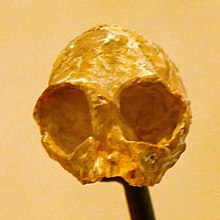
New World monkeys are the five families of primates that are found in the tropical regions of Mexico, Central and South America: Callitrichidae, Cebidae, Aotidae, Pitheciidae, and Atelidae. The five families are ranked together as the Ceboidea, the only extant superfamily in the parvorder Platyrrhini.
Branisella is an extinct genus of New World monkey from the Salla Formation of what is now Bolivia during the Late Oligocene, approximately 26 million years ago (Deseadan), comprising only the species Branisella boliviana. Together with the Peruvian genus Canaanimico, it is the oldest fossil New World monkey discovered.
Stirtonia is an extinct genus of New World monkeys from the Middle Miocene. Its remains have been found at the Konzentrat-Lagerstätte of La Venta in the Honda Group of Colombia. Two species have been described, S. victoriae and the type species S. tatacoensis. Synonyms are Homunculus tatacoensis, described by Ruben Arthur Stirton in 1951 and Kondous laventicus by Setoguchi in 1985. The genus is classified in Alouattini as an ancestor to the modern howler monkeys.

Dendropithecus is an extinct genus of apes native to East Africa between 20 and 15 million years ago. Dendropithecus was originally suggested to be related to modern gibbons, based primarily on similarities in size, dentition, and skeletal adaptations. However, further studies have shown that Dendropithecus lacks derived hominoid traits. Instead, the traits shared between this taxon and modern primates are primitive for all catarrhines. Dendropithecus is now considered to be a stem catarrhine, too primitive to be closely related to any modern primates.
Acrecebus is a prehistoric cebid monkey from the Late Miocene Solimões Formation of Acre State, Brazil and Bolivia. The only species known is A. fraileyi. This genus is closely related to the genus Cebus.
Solimoea acrensis is a prehistoric ateline monkey from the Late Miocene Solimões Formation of Brazil. It is the only known species of the genus Solimoea.
Protopithecus is an extinct genus of large New World monkey that lived during the Pleistocene. Fossils have been found in the Toca da Boa Vista cave of Brazil, as well as other locales in the country. Fossils of another large, but less robust ateline monkey, Caipora, were also discovered in Toca da Boa Vista.
Aotus dindensis is an extinct species of New World monkeys in the genus Aotus from the Middle Miocene. Its remains have been found at the Konzentrat-Lagerstätte of La Venta in the Honda Group of Colombia.
Nuciruptor is an extinct genus of New World monkeys from the Middle Miocene. Its remains have been found at the Konzentrat-Lagerstätte of La Venta in the Honda Group of Colombia. The type species is N. rubricae.
Panamacebus is an extinct genus of monkey known from the Early Miocene of central Panama. Panamacebus transitus is the only and type species of this genus.

Cebupithecia is an extinct genus of New World monkeys from the Middle Miocene. Its remains have been found at the Konzentrat-Lagerstätte of La Venta in the Honda Group of Colombia. The type species is C. sarmientoi.
Lagonimico is an extinct genus of New World monkeys from the Middle Miocene. Its remains have been found at the Konzentrat-Lagerstätte of La Venta in the Honda Group of Colombia. The type species is L. conclucatus.
Micodon is an extinct genus of New World monkeys from the Middle Miocene. Its remains have been found at the Konzentrat-Lagerstätte of La Venta in the Honda Group of Colombia. The type species is M. kiotensis, a very small monkey among the New World species.
Miocallicebus is an extinct genus of New World monkeys from the Middle Miocene. Its remains have been found at the Konzentrat-Lagerstätte of La Venta in the Honda Group of Colombia. The type species is Miocallicebus villaviejai.
Mohanamico is an extinct genus of New World monkeys from the Middle Miocene. Its remains have been found at the Konzentrat-Lagerstätte of La Venta in the Honda Group of Colombia. The type species is M. hershkovitzi. Due to the relatively few material found of Mohanamico, the placement of the genus is not certain and four possible families have been proposed by different authors, Atelidae, Callitrichidae, Pitheciidae or Aotidae.
Patasola is an extinct genus of New World monkeys from the Middle Miocene. Its remains have been found at the Konzentrat-Lagerstätte of La Venta in the Honda Group of Colombia. The type species is Patasola magdalenae.
Saimiri annectens, originally described as Laventiana annectens and later as Neosaimiri annectens, is an extinct species of New World monkey in the genus Saimiri from the Middle Miocene. Its remains have been found at the Konzentrat-Lagerstätte of La Venta in the Honda Group of Colombia.
Saimiri fieldsi is an extinct species of New World monkey in the genus Saimiri from the Middle Miocene. Its remains have been found at the Konzentrat-Lagerstätte of La Venta in the Honda Group of Colombia.







